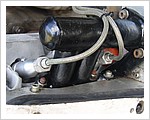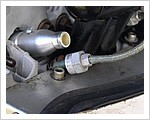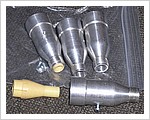From the NGK Website:
Spark Plug Installation Instructions
- Installing spark plugs
Torque is one of the most critical aspects of spark plug installation. Torque directly affects the spark plugs’ ability to transfer heat out of the combustion chamber. A spark plug that is under-torqued will not be fully seated on the cylinder head, hence heat transfer will be slowed. This will tend to elevate combustion chamber temperatures to unsafe levels, and pre-ignition and detonation will usually follow. Serious engine damage is not far behind.
An over-torqued spark plug can suffer from severe stress to the Metal Shell which in turn can distort the spark plug’s inner gas seals or even cause a hairline fracture to the spark plug’s insulator…in either case, heat transfer can again be slowed and the above mentioned conditions can occur.
The spark plug holes must always be cleaned prior to installation, otherwise you may be torquing against dirt or debris and the spark plug may actually end up under-torqued, even though your torque wrench says otherwise. Of course, you should only install spark plugs in a cool engine, because metal expands when its hot and installation may prove difficult. Proper torque specs for both aluminum and cast iron cylinder heads are listed below.
| Spark plug type | Thread Diameter | Cast Iron Cylinder Head (lb-ft.) | Aluminum Clyinder Head (lb-ft.) |
| Flat seat type (with gasket) | 18 ø mm | 25.3~32.5 | 25.3~32.5 |
| “ | 14 ø mm | 18.0~25.3 | 18.0~21.6 |
| “ | 12 ø mm | 10.8~18.0 | 10.8~14.5 |
| “ | 10 ø mm | 7.2~10.8 | 7.2~8.7 |
| “ | 8 ø mm | — | 5.8~7.2 |
| Conical seat type (without gasket) | 18 ø mm | 14.5~21.6 | 14.5~21.6 |
| Conical seat type (without gasket) | 14 ø mm | 10.8~18.0 | 7.2~14.5 |
- Installing spark plugs – Lawn & Garden Equipment
- Confirm that the thread reach of the spark plug is the right one for your engine.
- Remove the dirt at the gasket seal of the cylinder head.
- Tighten the spark plug finger tight until the gasket reaches the cylinder head, then tighten about 1/2-2/3 turn more with a spark plug wrench.(Taper seat: About 1/16 turn more).back to top
- Gapping
Since the gap size has a direct affect on the spark plug’s tip temperature
and on the voltage necessary to ionize (light) the air/fuel mixture, careful attention is required. While it is a popular misconception that plugs are pre-gapped from the factory, the fact remains that the gap must be adjusted for the vehicle that the spark plug is intended for. Those with modified engines must remember that a modified engine with higher compression or forced induction will typically require a smaller gap settings (to ensure ignitability
in these denser air/fuel mixtures). As a rule, the more power you are making, the smaller the gap you will need.
A spark plug’s voltage requirement is directly proportionate to the gap size. The larger the gap, the more voltage is needed to bridge the gap. Most experienced tuners know that opening gaps up to present a larger spark to the air/fuel mixture maximizes burn efficiency. It is for this reason that most racers add high power ignition systems. The added power allows them to open the gap yet still provide a strong spark.
With this mind, many think the larger the gap the better. In fact, some aftermarket ignition systems boast that their systems can tolerate gaps that are extreme. Be wary of such claims. In most cases, the largest gap you can run may still be smaller than you think.
This is for racers only !!
Indexing refers to a process whereby auxiliary washers of varying thickness are placed under the spark plug’s shoulder so that when the spark plug is tightened, the gap will point in the desired direction.
However, without running an engine on a dyno, it is impossible to gauge which type of indexing works best in your engine. While most engines like the spark plug’s gap open to the intake valve, there are still other combinations that make more power with the gap pointed toward the exhaust valve.
In any case, engines with indexed spark plugs will typically make only a few more horsepower, typically less than 1% of total engine output. For a 500hp engine, you’d be lucky to get 5hp. While there are exceptions, the bottom line is that without a dyno, gauging success will be difficult.
Let’s make this really simple: when you need your engine to run a little cooler, run a colder plug. When you need your engine to run a little hotter, run a hotter spark plug. However, NGK strongly cautions people that going
to a hotter spark plug can sometimes mask a serious symptom of another problem that can lead to engine damage. Be very careful with heat ranges. Seek professional guidance if you are unsure.
With modified engines (those engines that have increased their compression) more heat is a by-product of the added power that normally comes with increased compression. In short, select one heat range colder for every 75-100 hp you add, or when you significantly raise compression. Also remember to retard the timing a little and to increase fuel enrichment and octane. These tips are critical when adding forced induction (turbos, superchargers or nitrous kits), and failure to address ALL of these areas
will virtually guarantee engine damage.
An engine that has poor oil control can sometimes mask the symptom temporarily by running a slightly hotter spark plug. While this is a “Band-Aid” approach, it is one of the only examples of when and why one would select
a hotter spark plug.
Be cautious! In reality, most “racing” spark plugs are just colder heat ranges of the street versions of the spark plug. They don’t provide any more voltage to the spark plug tip! Their internal construction is no different (in NGK’s case, as all of our spark plugs must conform to the same level of quality controls) than most standard spark plugs.
There are some exceptions, though. Extremely high compression cars or those running exotic fuels will have different spark plug requirements and hence NGK makes spark plugs that are well-suited for these requirements. They are classified as “specialized spark plugs for racing applications”. Some are built with precious metal alloy tips for greater durability and the ability to fire in denser or leaner air/fuel mixtures. However, installing the same spark plugs Kenny Bernstein uses in his 300+ mph Top Fuel car (running Nitromethane at a 2:1 air/fuel ratio and over 20:1 dynamic compression) in your basically stock Honda Civic (running 15:1 a/f ratios with roughly 9.5:1 compression) will do nothing for you! In fact, since Kenny’s plugs are fully 4 heat ranges colder, they’d foul out in your Honda in just a few minutes.
NGK as a company tries to stay clear of saying that a racing spark plug (or ANY spark plug) will give you large gains in horsepower. While certain spark plugs are better suited to certain applications (and we’re happy to counsel you in the right direction) we try to tell people that are looking to “screw in” some cheap horsepower that, in most cases, spark plugs are not the answer.
To be blunt, when experienced tuners build race motors, they select their spark plugs for different reasons: to remove heat more efficiently, provide sufficient spark to completely light all the air/fuel mixture, to survive the added stresses placed upon a high performance engine’s spark plugs,
and to achieve optimum piston-to-plug clearance.
Some of these “specialized racing plugs” are made with precious metal alloy center/ground electrodes or fine wire tips or retracted-nose insulators. Again, these features do not necessarily mean that the spark plug will allow the engine to make more power, but these features are what allow the spark plug to survive in these tortuous conditions. Most racers know screwing in a new set of spark plugs will not magically “unlock” hidden horsepower.
- Using high power ignition systems
Many of the more popular aftermarket ignition systems are of the capacitive discharge type. They store voltage, or accumulate it, until a point at which a trigger signal allows release of this more powerful spark. Companies like Mallory, MSD, Crane and Accel, to name a few, offer such systems.
They affect spark plugs in that they allow the gaps to be opened up to take advantage of the increased capacity. The theory is that the larger and the more intense the spark you are able to present to the air/fuel mixture, the more likely you will be to burn more fuel, and hence the more power you will make.
We encourage the use of such systems, but only on modified or older non-computer controlled vehicles.
In reality, computer controlled vehicles do such a good job of lighting off the air/fuel mixture (as evidenced by the ultra-low emissions), added ignition capacity would do little to burn more fuel since the stock configuration is doing such a good job. Older non-computer controlled vehicles or those
that have been modified with higher compression or boosted (nitrous, turbo, supercharged) engines can certainly take advantage of a more powerful ignition system.
Comment
Well, NGK should know… but I don’t think that’s very well explained, at least not the first part.
The plug requires a good contact with the head for efficient heat transfer *from the spark plug itself* as it runs very, very hot – the electrode projects directly into the flame front and is the hottest point in the whole engine – that’s why it’s made of extremely heat-resistant materials including ceramics which won’t melt in the furnace-like temperatures which occur at that point.
Without that good contact, the plug will not perform to specification.
But probably the most important reason for not undertorquing is so it won’t fall out.
And probably the most important reason for not overtorquing is so you don’t strip the thread.. allowing the plug to fall out.
But who am I to argue with NGK?
Automotive Sparkplugs in Limbach Engines
Latest information on plugs is that the Beru units originally supplied with the first full conversion harness which McPhee got in late 2004 are standard VW plugs, and that a Bosch or NGK equivalent in platinum should do the trick. Conventional NGK B6HS (or is it ES?) work perfectly. (August 2006)
1965 VOLKSWAGEN BEETLE 1.2 H4 D 1 bbl
Standard B6HS gap 0.024
Iridium IX BR6HIX gap 0.024
Limbach Plugs
Limbach have their own branded plugs which Nigel Baker thinks are possibly manufactured by NGK. They’re certainly very good plugs and with the appropriate harness are an excellent alternative. Nigel will try to find the NGK equivalent from Limbach, or perhaps another source for the same sparkplug.
Limbach also do a harness for auto plugs – the plugs are three electrode type with Limbach brand., are fully certified and can go on with only a log book entry.
See also G109 100 Hourly for REL37B information







